2012 PEUGEOT 308 air condition
[x] Cancel search: air conditionPage 60 of 328
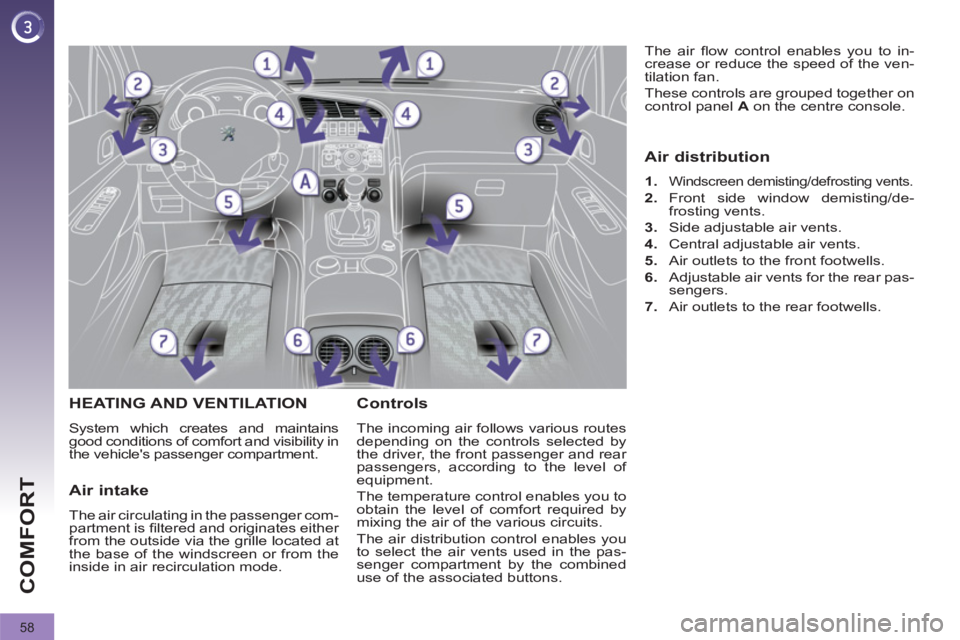
58
COMFORT
HEATING AND VENTILATION
System which creates and maintains
good conditions of comfort and visibi lity in
the vehicle's passenger compartment.
Controls
The incoming air follows various routes
depending on the controls selected by
the driver, the front passenger and rear
passengers, according to the level of
equipment.
The temperature control enables you to
obtain the level of comfort required by
mixing the air of the various circuits.
The air distribution control enables you
to select the air vents used in the pas-
senger compartment by the combined
use of the associated buttons. The air fl ow control enables you to in-
crease or reduce the speed of the ven-
tilation fan.
These controls are grouped together on
control panel A
on the centre console.
Air intake
The air circulating in the passenger com-
partment is fi ltered and originates either
from the outside via the grille located at
the base of the windscreen or from the
inside in air recirculation mode.
Air distribution
1.
Windscreen demisting/defrosting vents.
2.
Front side window demisting/de-
frosting vents.
3.
Side adjustable air vents.
4.
Central adjustable air vents.
5.
Air outlets to the front footwells.
6.
Adjustable air vents for the rear pas-
sengers.
7.
Air outlets to the rear footwells.
Page 61 of 328
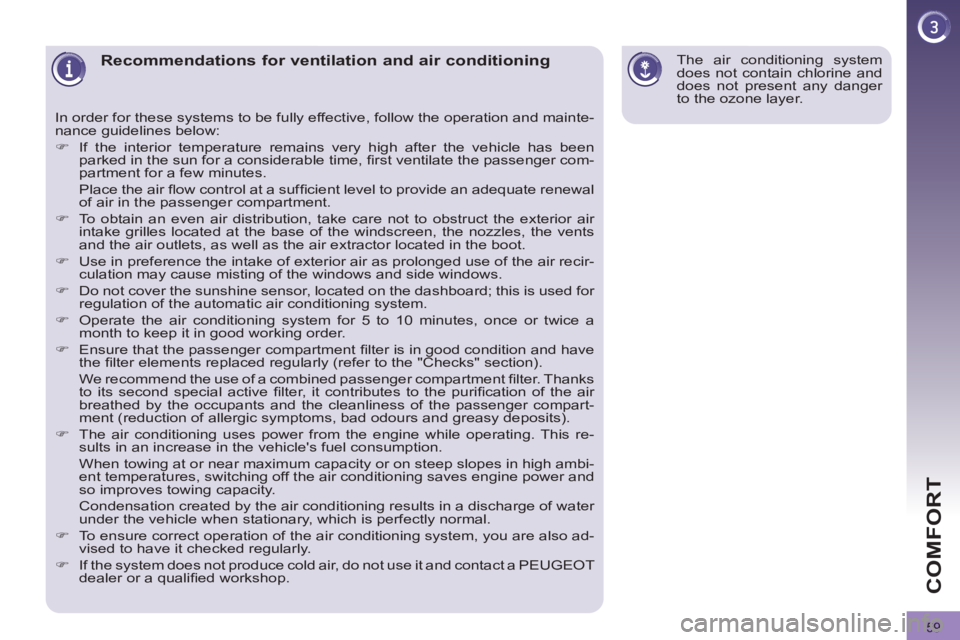
59
COMFORT
Recommendations for ventilation and air conditioning
In order for these systems to be fully effective, follow the operation and mainte-
nance guidelines below:
�)
If the interior temperature remains very high after the vehicle has been
parked in the sun for a considerable time, fi rst ventilate the passenger com-
partment for a few minutes.
Place the air fl ow control at a suffi cient level to provide an adequate renewal
of air in the passenger compartment.
�)
To obtain an even air distribution, take care not to obstruct the exterior air
intake grilles located at the base of the windscreen, the nozzles, the vents
and the air outlets, as well as the air extractor located in the boot.
�)
Use in preference the intake of exterior air as prolonged use of the air recir-
culation may cause misting of the windows and side windows.
�)
Do not cover the sunshine sensor, located on the dashboard; this is used for
regulation of the automatic air conditioning system.
�)
Operate the air conditioning system for 5 to 10 minutes, once or twice a
month to keep it in good working order.
�)
Ensure that the passenger compartment fi lter is in good condition and have
the fi lter elements replaced regularly (refer to the "Checks" section).
We recommend the use of a combined passenger compartment fi lter. Thanks
to its second special active fi lter, it contributes to the purifi cation of the air
breathed by the occupants and the cleanliness of the passenger compart-
ment (reduction of allergic symptoms, bad odours and greasy deposits).
�)
The air conditioning uses power from the engine while operating. This re-
sults in an increase in the vehicle's fuel consumption.
When towing at or near maximum capacity or on steep slopes in high ambi-
ent temperatures, switching off the air conditioning saves engine power and
so improves towing capacity.
Condensation created by the air conditioning results in a discharge of water
under the vehicle when stationary, which is perfectly normal.
�)
To ensure correct operation of the air conditioning system, you are also ad-
vised to have it checked regularly.
�)
If the system does not produce cold air, do not use it and contact a PEUGEOT
dealer or a qualifi ed workshop.
The air conditioning system
does not contain chlorine and
does not present any danger
to the ozone layer.
Page 62 of 328
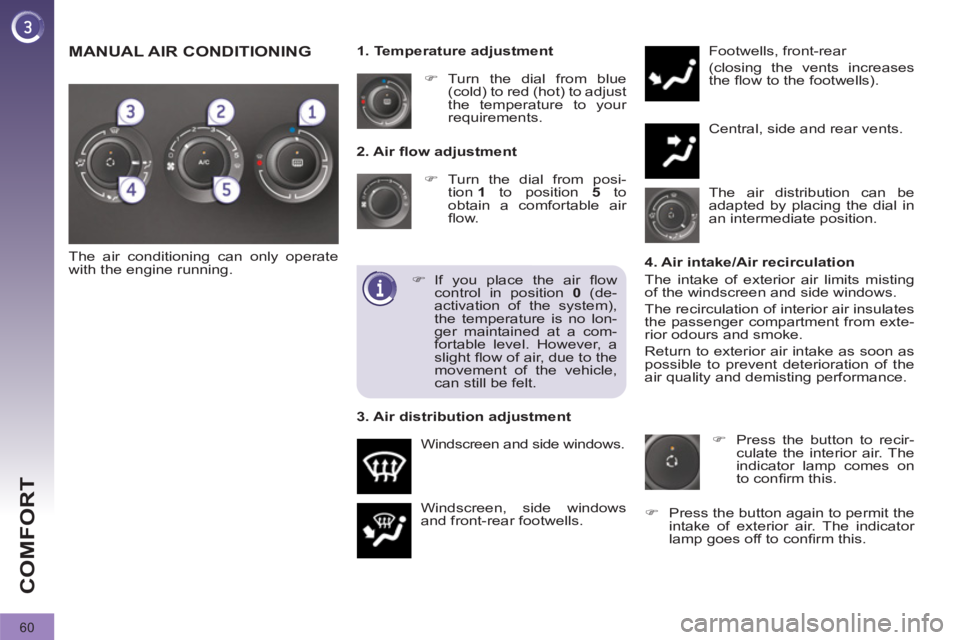
60
COMFORT
2. Air fl ow adjustment
�)
Turn the dial from posi-
tion 1
to position 5
to
obtain a comfortable air
fl ow.
Windscreen, side windows
and front-rear footwells. Footwells, front-rear
(closing the vents increases
the fl ow to the footwells).
Central, side and rear vents.
�)
Turn the dial from blue
(cold) to red (hot) to adjust
the temperature to your
requirements.
Windscreen and side windows.
1. Temperature adjustment
The air distribution can be
adapted by placing the dial in
an intermediate position.
The air conditioning can only operate
with the engine running.
4. Air intake/Air recirculation
The intake of exterior air limits misting
of the windscreen and side windows.
The recirculation of interior air insulates
the passenger compartment from exte-
rior odours and smoke.
Return to exterior air intake as soon as
possible to prevent deterioration of the
air quality and demisting performance.
�)
If you place the air fl ow
control in position 0
(de-
activation of the system),
the temperature is no lon-
ger maintained at a com-
fortable level. However, a
slight fl ow of air, due to the
movement of the vehicle,
can still be felt.
3. Air distribution adjustment
�)
Press the button to recir-
culate the interior air. The
indicator lamp comes on
to confi rm this.
�)
Press the button again to permit the
intake of exterior air. The indicator
lamp goes off to confi rm this.
MANUAL AIR CONDITIONING
Page 63 of 328
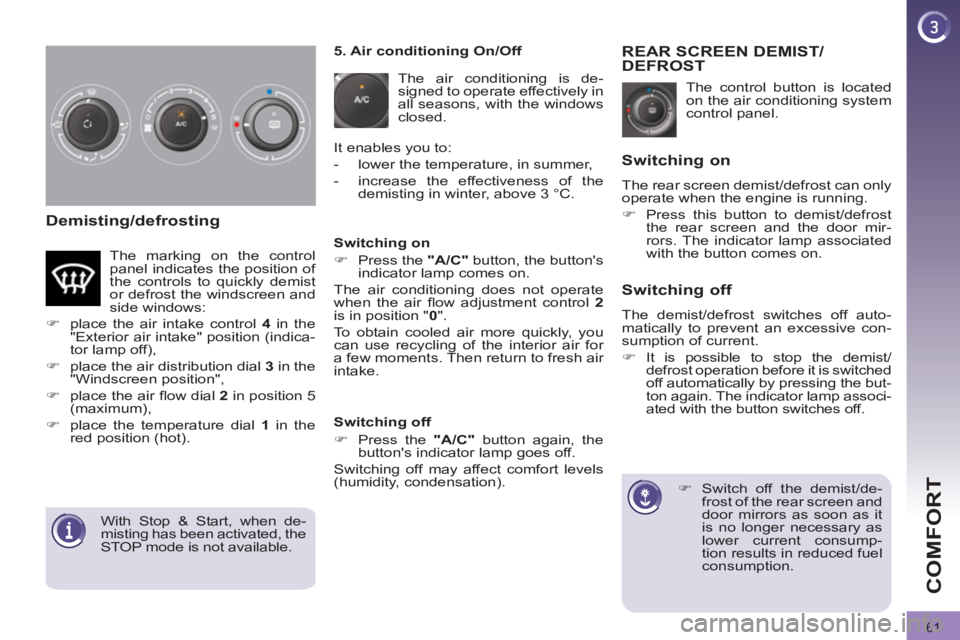
61
COMFORT
Demisting/defrosting
The control button is located
on the air conditioning system
control panel.
REAR SCREEN DEMIST/
DEFROST
�)
Switch off the demist/de-
frost of the rear screen and
door mirrors as soon as it
is no longer necessary as
lower current consump-
tion results in reduced fuel
consumption.
Switching on
The rear screen demist/defrost can only
operate when the engine is running.
�)
Press this button to demist/defrost
the rear screen and the door mir-
rors. The indicator lamp associated
with the button comes on.
Switching off
The demist/defrost switches off auto-
matically to prevent an excessive con-
sumption of current.
�)
It is possible to stop the demist/
defrost operation before it is switched
off automatically by pressing the but-
ton again. The indicator lamp associ-
ated with the button switches off.
5. Air conditioning On/Off
The air conditioning is de-
signed to operate effectively in
all seasons, with the windows
closed.
It enables you to:
- lower the temperature, in summer,
- increase the effectiveness of the
demisting in winter, above 3 °C.
Switching off
�)
Press the "A/C"
button again, the
button's indicator lamp goes off.
Switching off may affect comfort levels
(humidity, condensation).
Switching on
�)
Press the "A/C"
button, the button's
indicator lamp comes on.
The air conditioning does not operate
when the air fl ow adjustment control 2
is in position " 0
".
To obtain cooled air more quickly, you
can use recycling of the interior air for
a few moments. Then return to fresh air
intake. The marking on the control
panel indicates the position of
the controls to quickly demist
or defrost the windscreen and
side windows:
�)
place the air intake control 4
in the
"Exterior air intake" position (indica-
tor lamp off),
�)
place the air distribution dial 3
in the
"Windscreen position",
�)
place the air fl ow dial 2
in position 5
(maximum),
�)
place the temperature dial 1
in the
red position (hot).
With Stop & Start, when de-
misting has been activated, the
STOP mode is not available.
Page 64 of 328
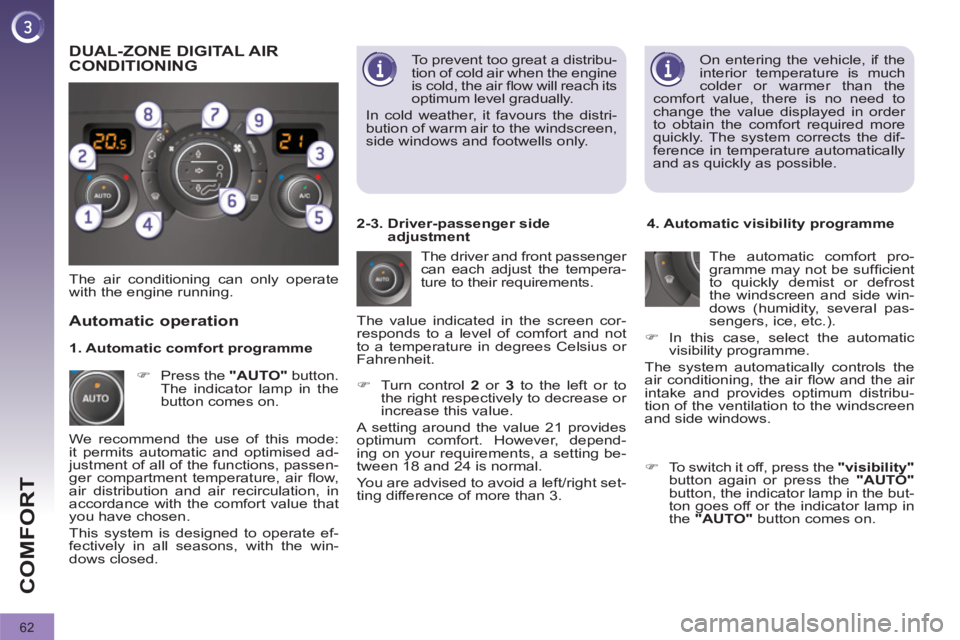
62
COMFORT
On entering the vehicle, if the
interior temperature is much
colder or warmer than the
comfort value, there is no need to
change the value displayed in order
to obtain the comfort required more
quickly. The system corrects the dif-
ference in temperature automatically
and as quickly as possible.
The air conditioning can only operate
with the engine running. The driver and front passenger
can each adjust the tempera-
ture to their requirements.
�)
Turn control 2
or 3
to the left or to
the right respectively to decrease or
increase this value.
A setting around the value 21 provides
optimum comfort. However, depend-
ing on your requirements, a setting be-
tween 18 and 24 is normal.
You are advised to avoid a left/right set-
ting difference of more than 3.
4. Automatic visibility programme
The automatic comfort pro-
gramme may not be suffi cient
to quickly demist or defrost
the windscreen and side win-
dows (humidity, several pas-
sengers, ice, etc.).
�)
In this case, select the automatic
visibility programme.
The system automatically controls the
air conditioning, the air fl ow and the air
intake and provides optimum distribu-
tion of the ventilation to the windscreen
and side windows.
Automatic operation
�)
Press the "AUTO"
button.
The indicator lamp in the
button comes on.
2-3. Driver-passenger side
adjustment
DUAL-ZONE DIGITAL AIR
CONDITIONING
We recommend the use of this mode:
it permits automatic and optimised ad-
justment of all of the functions, passen-
ger compartment temperature, air fl ow,
air distribution and air recirculation, in
accordance with the comfort value that
you have chosen.
This system is designed to operate ef-
fectively in all seasons, with the win-
dows closed. The value indicated in the screen cor-
responds to a level of comfort and not
to a temperature in degrees Celsius or
Fahrenheit.
�)
To switch it off, press the "visibility"
button again or press the "AUTO"
button, the indicator lamp in the but-
ton goes off or the indicator lamp in
the "AUTO"
button comes on.
1. Automatic comfort programme
To prevent too great a distribu-
tion of cold air when the engine
is cold, the air fl ow will reach its
optimum level gradually.
In cold weather, it favours the distri-
bution of warm air to the windscreen,
side windows and footwells only.
Page 65 of 328
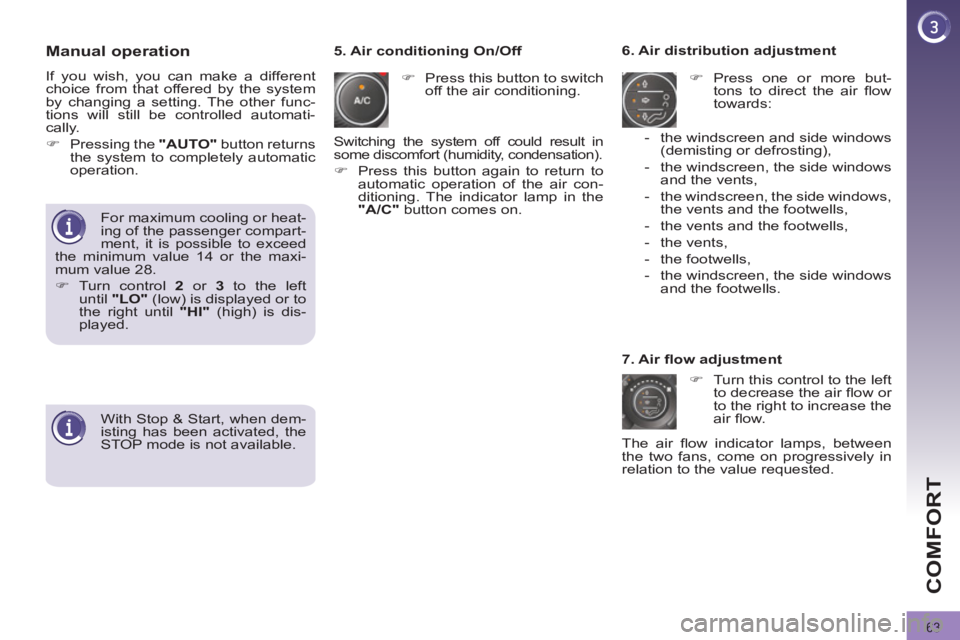
63
COMFORT
Manual operation
If you wish, you can make a different
choice from that offered by the system
by changing a setting. The other func-
tions will still be controlled automati-
cally.
�)
Pressing the "AUTO"
button returns
the system to completely automatic
operation.
�)
Press this button to switch
off the air conditioning.
6. Air distribution adjustment
�)
Press one or more but-
tons to direct the air fl ow
towards:
7. Air fl ow adjustment
�)
Turn this control to the left
to decrease the air fl ow or
to the right to increase the
air fl ow.
5. Air conditioning On/Off
- the windscreen and side windows
(demisting or defrosting),
- the windscreen, the side windows
and the vents,
- the windscreen, the side windows,
the vents and the footwells,
- the vents and the footwells,
- the vents,
- the footwells,
- the windscreen, the side windows
and the footwells.
The air fl ow indicator lamps, between
the two fans, come on progressively in
relation to the value requested. For maximum cooling or heat-
ing of the passenger compart-
ment, it is possible to exceed
the minimum value 14 or the maxi-
mum value 28.
�)
Turn control 2
or 3
to the left
until "LO"
(low) is displayed or to
the right until "HI"
(high) is dis-
played.
Switching the system off could result in
some discomfort (humidity, condensation).
�)
Press this button again to return to
automatic operation of the air con-
ditioning. The indicator lamp in the
"A/C"
button comes on.
With Stop & Start, when dem-
isting has been activated, the
STOP mode is not available.
Page 93 of 328
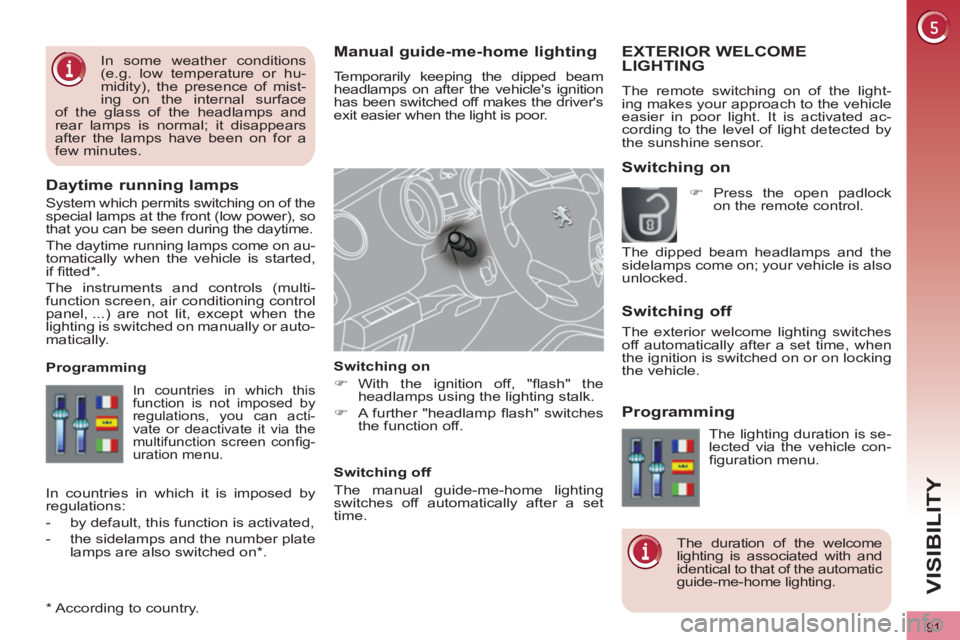
91
VISIBILITY
Manual guide-me-home lighting
Temporarily keeping the dipped beam
headlamps on after the vehicle's ignition
has been switched off makes the driver's
exit easier when the light is poor.
Switching on
�)
With the ignition off, "fl ash" the
headlamps using the lighting stalk.
�)
A further "headlamp fl ash" switches
the function off.
Switching off
The manual guide-me-home lighting
switches off automatically after a set
time.
Daytime running lamps
System which permits switching on of the
special lamps at the front (low power), so
that you can be seen during the daytime.
The daytime running lamps come on au-
tomatically when the vehicle is started,
if fi tted * .
The instruments and controls (multi-
function screen, air conditioning control
panel, ...) are not lit, except when the
lighting is switched on manually or auto-
matically.
*
According to country.
EXTERIOR WELCOME
LIGHTING
The remote switching on of the light-
ing makes your approach to the vehicle
easier in poor light. It is activated ac-
cording to the level of light detected by
the sunshine sensor.
Switching on
Switching off
Programming
In countries in which this
function is not imposed by
regulations, you can acti-
vate or deactivate it via the
multifunction screen confi g-
uration menu.
Programming
The lighting duration is se-
lected via the vehicle con-
fi guration menu.
The duration of the welcome
lighting is associated with and
identical to that of the automatic
guide-me-home lighting.
In countries in which it is imposed by
regulations:
- by default, this function is activated,
- the sidelamps and the number plate
lamps are also switched on * .
�)
Press the open padlock
on the remote control.
The dipped beam headlamps and the
sidelamps come on; your vehicle is also
unlocked.
In some weather conditions
(e.g. low temperature or hu-
midity), the presence of mist-
ing on the internal surface
of the glass of the headlamps and
rear lamps is normal; it disappears
after the lamps have been on for a
few minutes.
The exterior welcome lighting switches
off automatically after a set time, when
the ignition is switched on or on locking
the vehicle.
Page 127 of 328
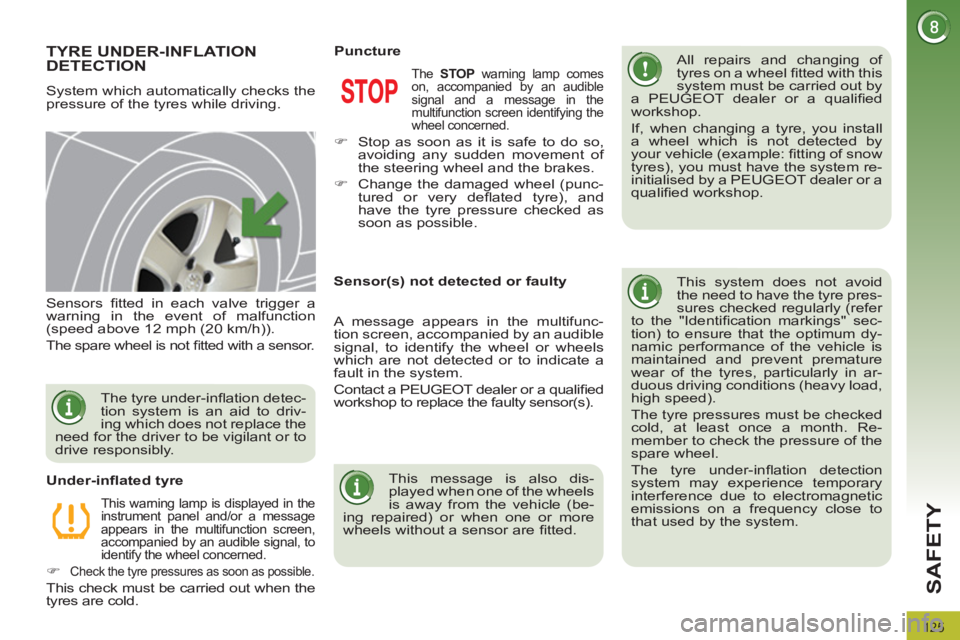
125
SAFETY
TYRE UNDER-INFLATION
DETECTION
System which automatically checks the
pressure of the tyres while driving.
All repairs and changing of
tyres on a wheel fi tted with this
system must be carried out by
a PEUGEOT dealer or a qualifi ed
workshop.
If, when changing a tyre, you install
a wheel which is not detected by
your vehicle (example: fi tting of snow
tyres), you must have the system re-
initialised by a PEUGEOT dealer or a
qualifi ed workshop.
This system does not avoid
the need to have the tyre pres-
sures checked regularly (refer
to the "Identifi cation markings" sec-
tion) to ensure that the optimum dy-
namic performance of the vehicle is
maintained and prevent premature
wear of the tyres, particularly in ar-
duous driving conditions (heavy load,
high speed).
The tyre pressures must be checked
cold, at least once a month. Re-
member to check the pressure of the
spare wheel.
The tyre under-infl ation detection
system may experience temporary
interference due to electromagnetic
emissions on a frequency close to
that used by the system.
Sensors fi tted in each valve trigger a
warning in the event of malfunction
(speed above 12 mph (20 km/h)).
The spare wheel is not fi tted with a sensor.
This warning lamp is displayed in the
instrument panel and/or a message
appears in the multifunction screen,
accompanied by an audible signal, to
identify the wheel concerned.
�)
Check the tyre pressures as soon as possible.
This check must be carried out when the
tyres are cold.
Under-infl ated tyre
The STOP
warning lamp comes
on, accompanied by an audible
signal and a message in the
multifunction screen identifying the
wheel concerned.
�)
Stop as soon as it is safe to do so,
avoiding any sudden movement of
the steering wheel and the brakes.
�)
Change the damaged wheel (punc-
tured or very defl ated tyre), and
have the tyre pressure checked as
soon as possible.
Puncture
The tyre under-infl ation detec-
tion system is an aid to driv-
ing which does not replace the
need for the driver to be vigilant or to
drive responsibly.
Sensor(s) not detected or faulty
A message appears in the multifunc-
tion screen, accompanied by an audible
signal, to identify the wheel or wheels
which are not detected or to indicate a
fault in the system.
Contact a PEUGEOT dealer or a qualifi ed
workshop to replace the faulty sensor(s).
This message is also dis-
played when one of the wheels
is away from the vehicle (be-
ing repaired) or when one or more
wheels without a sensor are fi tted.